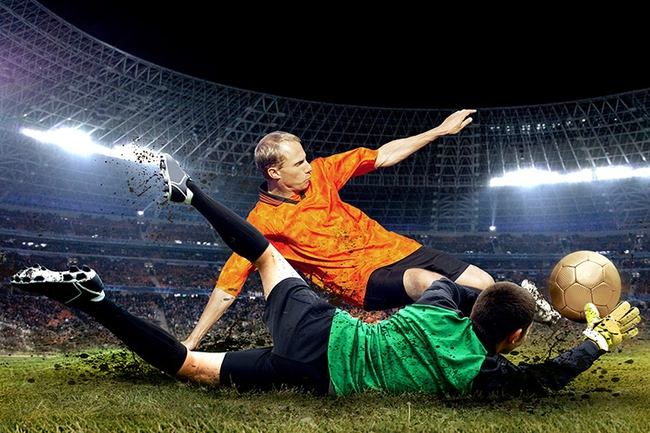Sports photography is a significant segment of the industry, and there are plenty of opportunities here if you're looking for another source of revenue for your photography business. Even if you aren't an athlete yourself, snapping images of players or sportspeople is a great way to expand your photography skill set. Capturing action at the fast pace of athletic events makes for a challenging photographic assignment. Practicing action shots for sports photography can improve your camera skills, open up more creative possibilities, and enhance your photography game overall. Here are a few tips that could help you get started.
What is Sports Photography?
This type of photography is all about documenting an athletic event. It could be a major game, or it could just be early season practice. Local community teams range from high schools to professional-level organizations.
When it comes to what counts as a sport, you need to keep an open mind. While football, baseball, or basketball are obvious, these major sports are just the tip of the iceberg. Golf, tennis, swim meets, track and field events, cycling tours, skiing, and water sports count too. The list goes on and on, but if it involves people pursuing athletic achievement with a mix of competitive spirit, chances are there's an opportunity for an enterprising sports photographer.

Best Camera Equipment for Sports Photography
Athletic events often occur outdoors in the evening or night, with artificial lighting of varying quality. Figuring out the best camera for creative sports photography ideas and the best lens for sports photography requires thinking about your goals and the exact conditions you are likely to face. It won’t be the same for every sport, but here are some rough guides to help you choose.
Camera Body
You can use pretty much any DSLR camera to shoot sports, but some are better than others. The primary considerations when picking the best camera for athletic photography are all about speed. Autofocusing systems are one of the main things that set professional bodies apart from consumer and prosumer level setups. They can all shoot sports, but the more advanced autofocus should be able to keep more images in sharper focus. With fast-moving action, lesser cameras will put out some blurry photos while they struggle to keep up with the action.
Another useful tool for the sports photographer is the burst mode. Advanced cameras can capture more photos in burst mode before they must pause to write the images to memory. The burst mode is essential because as the action happens, you won't have time to pick and choose the shot you like best. If you wait for a better angle or a better facial expression, something unexpected is bound to happen, and the entire shot is lost forever. It's far better to hit the burst mode from the beginning and plan to delete a bunch of photos. And what you really don’t want to happen is to find the limit of the burst mode and be out of commission for a few seconds.
One expensive upgrade you might want to consider forgoing on your sports camera body is a full-frame sensor. The only advantage a full-frame sensor will give you in sports is their amazing low light abilities. That's certainly not to say that full-frames are ill-suited to doing sports, just that crop sensors have one significant advantage. As you will see below, getting a tight shot is of paramount importance. A cropped-sensor camera gives you more focal length for your lenses, meaning you're already zoomed in a little more which may save you a little money on your lens.
You also want to consider the ergonomics of the camera you are using for sports. Many compact cameras, like newer mirrorless models, eliminate buttons and integrate them into touchscreen menus. Smaller bodies found on the cheapest entry-level consumer DSLRs often have the buttons, but they're built small and can be hard to get to quickly. Ideally, you want a camera that works so well you don't have to take your eye out of the viewfinder to find what you need. Your fingers just know where to go. Yes, this is all about learning to use your camera exceptionally well until it is muscle memory. But it's also about having a camera that was designed with this type of use in mind.
Lenses
Like many other forms of photography, the lens you pick for sports is going to have a considerable effect on your photos. The lenses you choose need to do two things. They need to get you as close to the action as possible, and they need to work fast in the lowest light.
These requirements mean that the best lens for sports photography is going to be a telephoto lens with the widest aperture you can afford. Check out the sidelines of any major sporting event, and you are bound to be impressed with the glass you see. The pros are packing some serious heat to these games.
Does that mean you need to drop ten or fifteen grand on a 1500 mm monster? Probably not. A telephoto zoom lens is likely a great choice since it will enable you to zoom out a bit as the action gets closer. A 100-400mm f/4 or lower lens makes a great sports starter lens.
Another lens feature to look for that will help in low-light situations is some form of stabilization. Canon calls theirs IS, Nikon calls it VR, and Sony makes OS. Whatever the acronym is, the purpose is simple. These systems reduce vibrations and camera shake to keep images sharp at low-light levels. It is especially helpful with the long lenses and quick action at the game.
Other Equipment
Shooting sports usually means forgoing flashes and strobes. A beefy tripod is a must-have, especially if you are using a massive lens. Many of these lenses are just too heavy to hold anyway, but regardless of their size and weight, you will get sharper photos while using a tripod.
If you shoot with a smaller, portable lens and you move around a lot during the game, a monopod might be a better alternative. It will give you the mobility to set up where ever on the sidelines you desire and keep moving as the action changes. But it still allows you to rest the camera on a solid object and to eliminate shake that will make blurry photos.
Sports Photography - Top 15 Tips for taking perfectly-timed sports pictures
Know the Rules of the Game
You don't need to have ever played the game you're photographing, but you do need to have some idea of how it works. If you're a complete newbie, go online to familiarize yourself with how it's played. Pretend that you're going to play it yourself. What's the objective, and where do players need to be to score the point? Go to a game or two as a spectator. Once you've figured out the basics, it will be a lot easier to figure out the critical things, like where do you need to be to capture great images.
Research What the "Expected" Photos Look Like
While you're doing all of this research, don't forget to check out the work of other photographers. Peruse images from past games of the team you're shooting, as well as professional shots that have made it into the papers and online stories. Look for things you like that you can emulate. Also, look for things you dislike, or for technical errors in the photos. Learn from others' mistakes.
Remember, photography as an art form is a never-ending process of learning. It is an amalgamation of technical skills, ideas, and creativity. Even as a professional photographer, there will always be more you can learn. So you have to keep practising.

The Ball is Always Headed Right For You
The sporting adage "keep your eyes on the ball" is also apt for photographers. Call it Murphy's Law or just bad luck, but the ball always seems aimed right at the photographer with the most expensive equipment. So keep an eye out for incoming projectiles, and keep moving around. You've been warned.
Know Your Camera Interface Like the Back of Your Hand
The action on the field is going to demand your full attention. You just don't have time to play with new settings or to realize halfway through that your camera has a continuous focus mode that you've never played with. You need to know your camera, and you need to know how to set it up for different shots on the fly. The best camera for sports photography will have its essential settings on dedicated buttons. If you learn the equipment well enough, you should be able to make any changes you need to without taking your eye out of the viewfinder.
Don't Waste Your Time Chimping
Chimping means checking out your photos as you go on the back of your camera. There might be times when you can take a quick look, but chances are you're missing something. It's far better to just shoot and worry about what you got later.
The exception to this rule would be when you need to make sure your settings are in order. Is the focus sharp enough for an upcoming sequence? Is your exposure perfect? Answer these questions early in the game. And consider taking some trash photos just to check the settings before the action happens.
Go Flashless
Flashes distract athletes and are generally bad form at sporting events. That means you're going to have to work with the light already there, and that means bringing fast lenses. It also means liberally apply high ISO settings, and maybe even a smaller depth of field than you're comfortable with from time to time. If your focusing is spot-on, you should be able to get away with it. If you want a quick recap of lighting for photography, read this article.
Use Shutter Priority Mode
What you don't want to compromise in your sports images is your shutter speed. Slow shutter speeds are not only going to lead to camera shake but also to motion blur. Sure, in some limited circumstances and with some planning motion blur can give the composition a fantastic artistic look. But that doesn't come around by accident; it's tricky to pull off. Most of the time, you want to avoid motion blur like the plague.

Consider using Back-Button Focusing
Most cameras come set up so that a half-push of the shutter button locks the exposure settings and the focus. Another way is to separate the two functions and use a focus button on the back of the camera. The higher-end camera bodies will have an AF button, while others might use a programmable function button. Either way, by using your thumb to focus the camera, you can get it to work a bit faster. It takes practice, but it does translate into more sharp pictures for most shooters.
Get the Best Access You Can
Your job is to get the shots the crowd can't, and that means getting better access to the game than most people have. If you're freelancing, you'll need to work with the facility or the manager of the team. They're not going to let anyone on the sidelines, so you'll want to make sure to put together your credentials in advance. Professional organizations will have a press pass application process, while neighborhood sports will be informal affairs. That doesn't mean you should just show up and start shooting, though. Make sure everyone there knows who you are and why you're there.
Shoot the Entire Event, Not Just the Action
The exciting bits of the game are easy to see. Goals, runs, shots, whatever is happening it will clearly cause excitement or disappointment. But your job goes beyond just the action on the field. Coaches, sideline moments, or fans shouting in the stands make great images that capture the events of the day. Look around and don't focus entirely on the players. Lulls in the game are great times to do this.
Tell the Story of the Game
In that vein, remember that your job is more than just to capture the highs and lows of the game. It's also to tell a story. The best sports photographers are storytellers, and they use their images to walk fans through the game day from start to finish. To tell the whole story, you're going to need more than just a handful of goal shots and running players.

Capture the Emotion of the Game
When shooting players, remember that humans are always looking to connect with each other using our faces. Action shots should always feature a facial expression, whether that expression is one of joy, concentration, frustration, or just intensity. This is how sports photographers capture the emotion of the game, and it shouldn't be underestimated. It's easy to capture a photo of the player running down the field, but capturing an action shot with the sweat dripping off of them as they intensely concentrate on the task at hand is another thing entirely.
Play with a Few Wide Angle Shots
While you're capturing the story, you might find that wide-angle shots can capture the scope of the events better. Not every sports shot is zoomed and cropped to the max.
If you decide to go this route, you really should have a second camera body set up with your wide-angle lens ready. You can't waste time switching lenses en situ, and you probably don't want to risk it anyway. Keep your equipment safe and clean by setting everything up in advance. If you're carrying two cameras, consider investing in some comfortable shoulder straps or even a holster style carrier.
But Keep Most Shots Tight
The wide-angle shots are fun and can help you tell your story, but in reality, these types of shots are what everyone else can get. The professional sports photographer is looking for the close-up action, so don't let these other options dilute your mission. Capture close up shots, with emotion and intensity.
Do check out these articles
How to Grow Your Sports Photography Business
If you think shooting local sporting events is something you'd like to try out, the number one rule should be not to go crazy buying all of the best equipment. As you've probably already figured out, the equipment needed to compete with the established big-name sports photographers is a significant barrier to entry. This isn't to discourage you from getting the equipment you need, just to point out that it's unlikely that this gear will pay for itself any time soon. If you go out and spend $30,000 on lenses and bodies, your break-even point isn't going to come for quite a while.
Most jobs for hometown sports photographers will go through the local papers and news sites. Chances are, they are looking for freelancers who will work with them for their local sports sections. Local media is a narrow-margin business these days, especially print newspapers. They've probably had to lay off sports staff and photographers and are looking to fill that section of the paper with local information that no one else has. Even the smallest towns follow their football teams or clubs with great interest.
You can also work with local high schools and colleges that have sports teams. These organizations usually have good coverage from fellow students, but there might be a place for professional photographers to come in every once in a while. Contact the athletic director at the school and chat about their needs and how you can help them out. Even if you start as a volunteer, chances are there will be plenty of opportunities for photo sales to the students and parents. Don't overlook non-headline sports like track and field, swim, golf, or cross country either.
Youth sports leagues in your community are another source of business potential. By working with the club organizers, you can document their games and sell the photos to excited sideline parents. Football, softball, lacrosse, cricket, or whatever else is played in your area all make perfect subjects.
The jobs above indicate reoccurring gigs that any photographer can track down regardless of where they live. But depending on where you are, you can probably find some more interesting and novel options as well. For example, beach towns might have local surfers looking for some shots, or even rowing clubs looking for promotional materials. Mountain areas have biking and winter sports. Many communities have race tracks and drag strips where motorheads meet up. Keep your eyes open for special events that tour through your area or only come once a season. Think outside the box and make new options for yourself.
Showcasing your curated work online through a well-made portfolio website is essential. Your photography portfolio website acts as your gateway to the world and the first interface between you and most potential clients. Hence, it’s essential that your photography portfolio website is designed to complement and showcase your work clearly without being distracting. Here are some winning tips to make your online portfolio stand out from the others.
Pixpa is an all-in-one website builder platform used by photographers around the world to build their portfolio websites. Pixpa enables you to not just beautifully showcase your projects; it also offers added capabilities like integrated blogging and client gallery tools.
Conclusion
There's plenty of demand for quality photography of sporting events, and it is a specialized skill that not everyone can do. All of this equals the potential for the enterprising photographer. Plus, it's a fun challenge that is very different from other forms of photography. Even if you aren't that into the game, you may find that you love shooting sports events.














